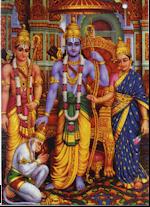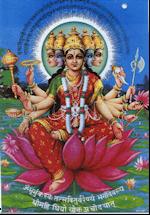|
Here we present
extensive resources for understanding the concept of God in Hindu dharma. The Hindu Trinity, forms of Gods and Goddesses, the Avatars of Lord Vishnu, the Devatas,
Planet and Animal
Deities are all presented with their image representation.
If you have ever wondered, if Hindus worship one God or many
Gods, why do Hindus worship images and icons, why does the God in Hindu dharma have
multiple names and multiple forms of God, then this is the where, we hope, you will find
answers. Dr. David Frawley has answered many of these commonly asked questions quite
succinctly. For example,
Why Do Hindus Worship Many Gods?
Human beings through history have formulated many different names and forms for the
Divine or Eternal. Just as we have many names and forms for other things, whether it is
foods, or types of art, so too, in religion a similar great diversity has been created.
The Western world has prided itself in monotheism, the idea that there is only One God as
the highest truth. Western religions have said that only the names and forms which refer
to this One God are valid but those which appear to worship another God, or a multiplicity
of divinities, must be false. They have restricted the names and forms they use in
religious worship, and insist that only one set is true and correct and others are wrong
or unholy.
As a universal formulation Hinduism accepts all formulations of Truth. According to the
universal view there is only One Reality, but it cannot be limit ed to a particular name
or form. Though Truth is One it is also Universal, not an exclusive formulation. It is an
inclusive, not an exclusive Oneness - a spiritual reality of Being -
Consciousness - Bliss,
which could be called God but which transcends all names. The different Gods and
Goddesses of Hinduism represent various functions of this One Supreme Divinity, and are
not separate Gods.
Having many names for something is not necessarily a sign of ignorance of its real nature.
On the contrary, it may indicate an intimate knowledge of it. For example, Eskimos have
forty-eight different names for snow in their language because they know snow intimately
in its different variations, not because they are ignorant of the fact that all snow is
only one. The many different deities of Hinduism reflect such an intimate realization of
the Divine on various levels.
Or, Why Does Hinduism Portray God as a Woman?
Hinduism contains many feminine forms of the Divine like Kali, Durga, Lakshmi and
Sarasvati. These represent different feminine qualities and functions of the Divine which
contains both male and female energies. For example, Kali portrays the destructive energy,
Lakshmi the nourishing, and Sarasvati the creative, while Durga is the Divine Mother in
her protective role. Hinduism also has many dual male-female forms like Radha-Krishna,
Sita-Rama, Uma-Mahesh, and Lakshmi -Narayan in which the female form is usually addressed
first. The different masculine forms of the Divine in Hinduism have their feminine
counterparts.
As Sanatana Dharma or a universal tradition Hinduism recognizes that the Divine contains
both masculine and feminine attributes. Without giving proper honor to the feminine
qualities a religion must be incomplete and one-sided, which must result in its teachings
having negative consequences. Without recognizing the feminine aspect of Divinity one
cannot claim to know God. To recognize the feminine is necessary to restore wholeness,
completeness and universality.
[ Up ] [ Next ]
|


